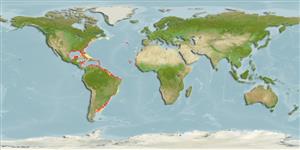Environment: milieu / climate zone / depth range / distribution range
Ökologie
seewasser; brackwasser benthopelagisch; tiefenbereich 0 - 55 m (Ref. 26912). Subtropical; 46°N - 45°S, 98°W - 16°W
Western Atlantic: Nova Scotia, Canada through most of the West Indies; along coasts of Gulf of Mexico and South America (Ref. 26938) to Mar del Plata, Argentina. Absent from the Bahamas (Ref. 26938). Replaced by Selene dorsalis in the eastern Atlantic. These two species have not been adequately studied and may prove to be conspecific. Known to occur in Mauritania (Ref. 5377).
Length at first maturity / Size / Gewicht / Alter
Maturity: Lm 20.5 range ? - ? cm
Max length : 60.0 cm TL Männchen/unbestimmt; (Ref. 26340); common length : 25.0 cm TL Männchen/unbestimmt; (Ref. 5217); max. veröff. Gewicht: 4.6 kg (Ref. 26340)
Rückenflossenstacheln (insgesamt): 9; Rückenflossenweichstrahlen (insgesamt): 21; Afterflossenstacheln 3; Afterflossenweichstrahlen: 17. Pelvic fin small (Ref. 13608). A very deep-bodied, short and strongly compressed fish. Facial profile nearly vertical and concave. Pelvic fin very short (Ref. 26938).
Adults usually found near the bottom from inshore waters to at least 54 m depth, but may form schools near the surface (Ref. 5217). Juveniles are found on muddy bottoms brackish estuaries and in coastal marine waters (Ref. 5217). Adults feed on small fishes and crustaceans. Good food fish and marketed fresh.
Cervigón, F., 1993. Los peces marinos de Venezuela. Volume 2. Fundación Científica Los Roques, Caracas,Venezuela. 497 p. (Ref. 9626)
IUCN Rote Liste Status (Ref. 130435)
Bedrohung für Menschen
Reports of ciguatera poisoning (Ref. 30911)
Nutzung durch Menschen
Fischereien: hoch kommerziell; Aquarium: Öffentliche Aquarien
Tools
Zusatzinformationen
Download XML
Internet Quellen
Estimates based on models
Preferred temperature (Ref.
123201): 12 - 27.9, mean 24.4 °C (based on 656 cells).
Phylogenetic diversity index (Ref.
82804): PD
50 = 0.5039 [Uniqueness, from 0.5 = low to 2.0 = high].
Bayesian length-weight: a=0.01288 (0.01144 - 0.01451), b=2.95 (2.92 - 2.98), in cm total length, based on LWR estimates for this species (Ref.
93245).
Trophic level (Ref.
69278): 3.7 ±0.52 se; based on food items.
Generation time: 2.2 ( na - na) years. Estimated as median ln(3)/K based on 2
growth studies.
Widerstandsfähigkeit (Ref.
120179): mittel, Verdopplung der Population dauert 1,4 - 4,4 Jahre. (tmax=4.5; assuming tm=2-3).
Prior r = 0.54, 95% CL = 0.36 - 0.81, Based on 2 stock assessments.
Fishing Vulnerability (Ref.
59153): Low to moderate vulnerability (29 of 100).
Climate Vulnerability (Ref.
125649): Moderate vulnerability (36 of 100).
Nutrients (Ref.
124155): Calcium = 72.3 [42.4, 149.2] mg/100g; Iron = 1.18 [0.66, 2.21] mg/100g; Protein = 18.5 [16.6, 20.8] %; Omega3 = 0.381 [0.226, 0.665] g/100g; Selenium = 30 [16, 56] μg/100g; VitaminA = 9.4 [3.0, 26.4] μg/100g; Zinc = 0.828 [0.587, 1.182] mg/100g (wet weight);
